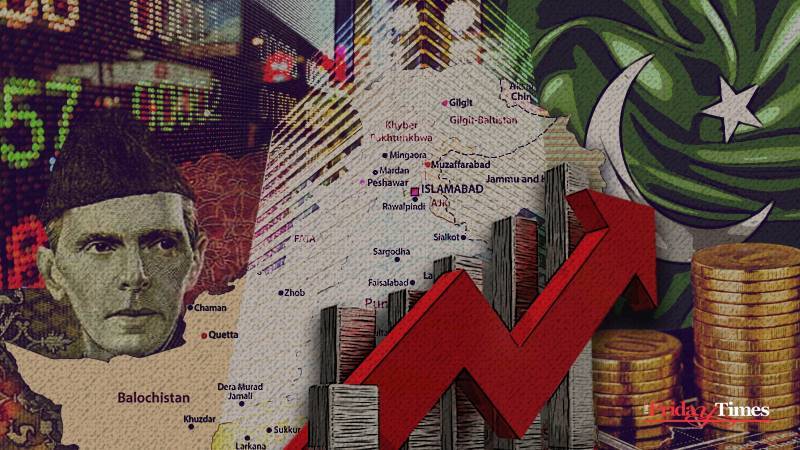
For the past 77 years, Pakistan’s economy has faced many challenges, and 2024 has been no exception, as the country faced a mix of challenges while struggling to recover and stabilize. Inflation surged to record levels, making everyday goods and services unaffordable for many, while the currency rapidly lost value, adding pressure to businesses and households. A widening fiscal deficit strained the government’s ability to manage public spending, and political uncertainty made it harder to address these economic problems effectively. On top of this, the global economy remained unstable, with unpredictable oil prices and fluctuating international markets making it even harder for Pakistan to find a clear path forward.
Inflation was a persistent concern that affected almost every household. Prices of everyday essentials, particularly food items and fuel, reached unprecedented levels, making necessities unaffordable for many families. The depreciation of the Pakistani rupee against major global currencies exacerbated the situation, driving up the cost of imports and adding to the financial burden on both consumers and businesses. For many, the struggle to make ends meet became a daily reality, and economic uncertainty cast a long shadow over their lives. Despite these difficulties, the government made strides in securing financial assistance and introducing economic reforms, though these measures brought their own set of challenges.
Pakistan’s partnership with the International Monetary Fund (IMF) played a key role in its efforts to stabilize the struggling economy. The financial assistance provided through the IMF program offered a lifeline, helping the country address its immediate financial needs. However, this aid came with strict conditions, such as cutting subsidies on essential items, raising taxes, and slashing government spending. While these measures were designed to support long-term economic recovery, they caused significant challenges in the short-term. Many people felt the impact directly, as the higher costs of living and reduced support from the government put additional strain on the already tight household budgets. The reforms sparked mixed reactions, with some viewing them as necessary sacrifices and others as burdens too heavy to bear.
Despite the tough challenges, there were glimmers of hope for Pakistan’s future. The young entrepreneurs showed remarkable resilience, pushing boundaries and achieving milestones that drew international attention
Agriculture, a key part of Pakistan's economy, faced major challenges due to unpredictable weather patterns and frequent floods in certain areas. These natural disasters disrupted crop production and added more pressure to a sector that was already struggling. In contrast, the services sector, particularly digital services and IT exports, showed potential for growth, gaining more recognition in the international markets. Additionally, Pakistan made efforts to improve trade ties with neighboring countries and Gulf states, but the full benefits of these initiatives will likely take time to fully materialize. Despite the setbacks in agriculture, these shifts toward services and regional trade could help drive long-term economic recovery.
Remittances from overseas Pakistanis have been a support for the country's economy, serving as an important source of foreign exchange. However, the growth in remittances slowed down in recent years, highlighting the need for a more varied approach to strengthen the nation's finances. In response, the government has focused on promoting public-private partnerships and attracting foreign direct investment to revive key industries. Despite these efforts, political instability and economic challenges have kept investor confidence low, limiting the effectiveness of these strategies in bringing about immediate improvements.
Despite the tough challenges, there were glimmers of hope for Pakistan’s future. The young entrepreneurs showed remarkable resilience, pushing boundaries and achieving milestones that drew international attention. Several startups successfully secured foreign investments, highlighting the potential of Pakistan’s talented and innovative youth to drive economic growth and bring fresh ideas to the global stage. At the same time, progress on infrastructure projects under the China-Pakistan Economic Corridor (CPEC) continued, offering a brighter outlook for the country’s connectivity and trade. These projects, aimed at improving roads, ports, and energy networks, provided a foundation for the long-term development and the promise of stronger economic ties with regional and global markets. Together, these sparks of progress reminded the nation of its untapped potential even in the face of adversity.
The road ahead is undoubtedly steep, with economic and political challenges that demand unwavering focus and determination. However, the resilience of its people and the untapped potential within its workforce and industries offer a glimmer of optimism. Sustainable growth will require not just bold policy decisions but also consistent implementation and a commitment to addressing the systemic issues that have hindered progress in the past. While the challenges are substantial, the opportunities for growth and recovery remain within reach if the nation can harness its collective strength and focus on building a more stable and prosperous future.

